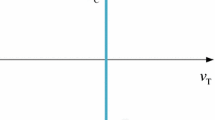Abstract
This paper aims to explain the basic physics concept of friction in a better way as it highlights the behavior of the body during motion considering the effect of friction. The paper combines physics and mathematics with equations and graphs. The investigation focuses the characteristics of a body in motion by keeping eye on friction by making graphical approach and also by quantitative study. The research establishes certain facts and points on friction. It establishes certain equations which helps the concept to understand better. A simple demonstration has been made for better understanding the concept. MATLAB software is used to draw the graphs. An algorithm has also been framed for step by step understanding and bringing clarity to the concept.
Access this chapter
Tax calculation will be finalised at checkout
Purchases are for personal use only
Preview
Unable to display preview. Download preview PDF.
Similar content being viewed by others
References
Verma, H.C.: Concepts of Physics, vol. I, 4th reprint, pp. 85–89. Bharati Bhawan Publishers and Distributaors, ISBN: 81-7709-187-5
Sears, F.W., Zemansky, M.W., Young, H.D.: University Physics, 6th edn., p. 59. Narosa Publishing House, ISBN: 81-85015-63-5
Rahman, M.R.: Alternate Derivation of Condition for minimum angle of deviation. Undergraduate Academic Reasearch Journal (UARJ) 1(3, 4), 8–10, ISSN: 2278-1129
Halliday, Resnick, Walker: Fundamentals of Physics, 8th edn., pp. 88–99. Wiley India, ISBN: 978-81-265-1442-7
Singh, D.B.: AIEEE Physics, p. 148. Arihant Prakashan, ISBN: 81-88222-32-1
Rahman, M.R.: Enhanced Approach of Computing Least Common Multiple (LCM). Dayananda Sagar International Journal (DSIJ) 1(1), 65–69, ISSN: 2347-1603
Kawagoe, K., Furutani, K.: Influence of friction force on seal mechanism with one degree of freedom. In: Proceedings of 2003 International Symposium on Micromechatronics and Human Science, MHS 2003, pp. 317–322 (2003) ISBN: 0-7803-8165-3
Ruan, J.-A., Bhushan, B.: Atomic-scale and microscale friction studies of graphite and diamond using friction force microscopy. Journal of Applied Physics 76(9), 5022–5035, ISSN: 0021-8979
Liew, J.Y., Chen, Y., Zhou, T.Y.: The measurement on vibration friction coefficient of ultrasonic motor. In: IEEE Ultrasonics Symposium, pp. 154–156 (2008) ISBN: 978-1-4244-2428-3
Li, B., Du, H., Li, W.: A novel cost effective method for vehicle tire-road friction coefficient estimation. In: IEEE/ASME International Conference on Advanced Intelligent Mechatronics (AIM), pp. 1528–1533 (2013) ISBN: 978-1-4673-5319-9
De Wit, C.C., Olsson, H., Astrom, K.J., Lischinsky, P.: A new model for control of systems with friction. IEEE Transactions on Automatic Control 40(3), 419–425, ISSN: 0018-9286
Chigira, Y., Fujii, Y., Valera, J.D.R.: Direct measurement of friction acting between a ballpoint pen and a paper. In: Annual Conference SICE, vol. 2, pp. 1518–1521 (2004) ISBN: 4-907764-22-7
Lu, Z., Zhang, D., Huang, X.: Influence of original paper formation and the resin impregnation uniformity on the wearing of the wet type (paper-based) friction material. In: 2011 International Conference on Remote Sensing, Environment and Transportation Engineering (RSETE), pp. 5034–5037, ISBN: 978-1-4244-9172-8
Huang, S.-J., Yen, J.-Y., Lu, S.-S.: Dual mode control of a system with friction. IEEE Transactions on Control Systems Technology 7(3), 306–314, ISSN: 1063-6536
Author information
Authors and Affiliations
Corresponding author
Editor information
Editors and Affiliations
Rights and permissions
Copyright information
© 2015 Springer International Publishing Switzerland
About this paper
Cite this paper
Rahman, M.R. (2015). Software and Graphical Approach for Understanding Friction on a Body. In: Satapathy, S., Biswal, B., Udgata, S., Mandal, J. (eds) Proceedings of the 3rd International Conference on Frontiers of Intelligent Computing: Theory and Applications (FICTA) 2014. Advances in Intelligent Systems and Computing, vol 328. Springer, Cham. https://doi.org/10.1007/978-3-319-12012-6_70
Download citation
DOI: https://doi.org/10.1007/978-3-319-12012-6_70
Publisher Name: Springer, Cham
Print ISBN: 978-3-319-12011-9
Online ISBN: 978-3-319-12012-6
eBook Packages: EngineeringEngineering (R0)




